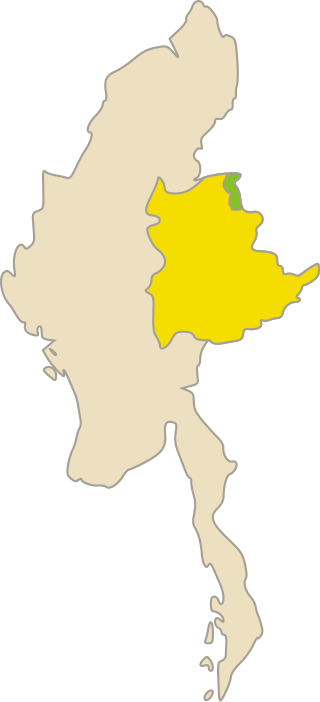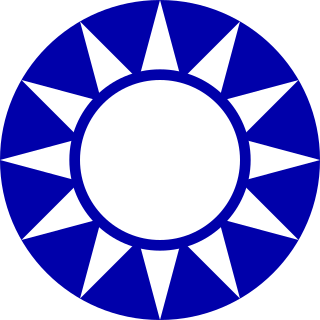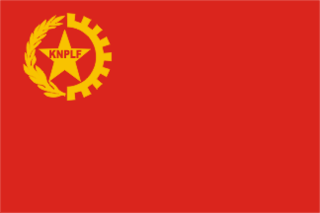
Shan State, also known by the endonym Shanland, is a state of Myanmar. Shan State borders China (Yunnan) to the north, Laos to the east, and Thailand to the south, and five administrative divisions of Burma (Myanmar) in the west. The largest of the 14 administrative divisions by land area, Shan State covers 155,800 km2, almost a quarter of the total area of Myanmar. The state gets its name from Burmese name for the Tai peoples: "Shan people". The Tai (Shan) constitute the majority among several ethnic groups that inhabit the area. Shanland is largely rural, with only three cities of significant size: Lashio, Kengtung, and the capital, Taunggyi. Taunggyi is 150.7 km northeast of the nation's capital Naypyitaw.

Kokang is a region in Myanmar. It is located in the northern part of Shan State, with the Salween River to its west, and sharing a border with China's Yunnan Province to the east. Its total land area is around 1,895 square kilometers (732 sq mi). The capital is Laukkai. Kokang is mostly populated by Kokang Chinese, a Han Chinese group living in Myanmar.

The United Wa State Army, abbreviated as the UWSA or the UWS Army, is the military wing of the United Wa State Party (UWSP), the de facto ruling party of Wa State in Myanmar. It is a well-equipped ethnic minority army of an estimated 20,000–30,000 Wa soldiers, led by Bao Youxiang. The UWSA was formed after the collapse of the armed wing of the Communist Party of Burma (CPB) in 1989.
Insurgencies have been ongoing in Myanmar since 1948, the year the country, then known as Burma, gained independence from the United Kingdom. The conflict has largely been ethnic-based, with several ethnic armed groups fighting Myanmar's armed forces, the Tatmadaw, for self-determination. Despite numerous ceasefires and the creation of autonomous self-administered zones in 2008, many armed groups continue to call for independence, increased autonomy, or the federalisation of the country. The conflict is the world's longest ongoing civil war, having spanned more than seven decades.

The Shan State Army – South, also known simply as the Shan State Army, is the armed wing of the Restoration Council of Shan State (RCSS) and one of the largest insurgent groups in Myanmar (Burma). The SSA-S was led by Lieutenant General Yawd Serk until his resignation on 3 February 2014. Yawd Serk was reelected chairman of the RCSS shortly after his resignation and has remained chairman since.

The Kokang incident was a violent series of skirmishes that broke out in August 2009 in Kokang in Myanmar's northern Shan State. Several clashes between the Burmese military junta forces and ethnic minorities took place. As a result of the conflict, the MNDAA lost control of the area and as many as 30,000 refugees fled to Yunnan province in neighbouring China.

The Kokang Chinese are Mandarin-speaking Han Chinese living in Kokang, Myanmar, administered as the Kokang Self-Administered Zone.
Pheung Kya-shin was the chairman of the Kokang Special Region in Myanmar (Burma) and the leader of the Myanmar National Democratic Alliance Army (MNDAA).

The Mong Tai Army, was an insurgent group consisting of soldiers from the Shan minority in Myanmar, founded in 1985 by Khun Sa. It had up to 20,000 armed troops at its peak, and was one of the largest forces opposing the government of Myanmar at its time. It was also involved in drug trafficking in Southeast Asia.
Yang Mao-liang is a high-ranking member of the Myanmar National Democratic Alliance Army (MNDAA). He was ousted by Peng Jiasheng from MNDAA and Kokang. Yang Mao-Liang established the Peace Myanmar Group company a water and alcoholic beverage manufacture at year of 1993.

The Shan State Army – North, also known as Shan State Army/Special Region 3 (SSA/SR-3) is a Shan nationalist insurgent group in Myanmar (Burma). It is the armed wing of the Shan State Progress Party (SSPP).

The National Democratic Alliance Army (NDAA) is an insurgent group in eastern Shan State, Myanmar (Burma). It is the armed wing of the Peace and Solidarity Committee (PSC).

The Myanmar National Democratic Alliance Army (MNDAA) is an armed resistance group in the Kokang region, Myanmar (Burma). The army has existed since 1989, having been the first one to sign a ceasefire agreement with the Burmese government. The ceasefire lasted for about two decades.

The 2015 Kokang offensive was a series of military operations launched by the Myanmar Army in 2015 in Kokang in northern Shan State, Myanmar (Burma). Several clashes between the Myanmar Army and Myanmar National Democratic Alliance Army had taken place from February to May 2015.

The Kuomintang in Burma or Kuomintang in the Golden Triangle were Kuomintang troops that fled from Communist-controlled China to Burma in 1950 after their defeat by the Communists in the Chinese Civil War. Officially the Yunnan Anti-communist National Salvation Army, the Chinese Nationalist troops in Burma were commanded by General Li Mi. It attempted several incursions into Yunnan in the early 1950s, only to be pushed back into Burma each time by the Chinese Communist Party's People's Liberation Army.

The Karenni National People's Liberation Front (KNPLF) is a communist and Karenni nationalist insurgent group active in Kayah State, Myanmar (Burma). It agreed to become a government-sponsored border guard force on 8 November 2009 although it remains active under the name of KNPLF. Starting from 13 June 2023, it has decided to change to side with Karen National Liberation Army (KNLA), Karenni Army (KA), Karenni Nationalities Defense Force (KNDF), and People's Defense Force (PDF) and fight the military regime.

Border Guard Forces are subdivisions of the Tatmadaw consisting of former insurgent groups in Myanmar under the instruction of Regional Military Commands. The government announced its plan to create Border Guard Forces in April 2009, in the hopes of ending hostilities between the government and insurgent groups leading up to the 2010 general election.
The Muse offensive, also known as the Mong Ko offensive, was a joint military operation by members of the Northern Alliance, which consists of the Arakan Army (AA), the Kachin Independence Army (KIA), the Myanmar National Democratic Alliance Army (MNDAA) and the Ta'ang National Liberation Army (TNLA). The groups targeted towns and border posts along the China–Myanmar border in Muse Township, Myanmar.
Lin Mingxian is the chairman of the National Democratic Alliance Army (NDAA) and the leader of the Shan State Special region 4.
The Federal Political Negotiation and Consultative Committee is an alliance and coalition of seven ethnic armed organisations (EAOs) in Myanmar seeking to negotiate with the central government. Four FPNCC members – the Arakan Army (AA), the Kachin Independence Army (KIA), the Myanmar National Democratic Alliance Army (MNDAA) and the Ta'ang National Liberation Army (TNLA) – are also members of the Northern Alliance. FPNCC is the largest negotiating body of EAOs in the country. The Chinese government formally engages with FPNCC, which is also recognised by the Chinese government as an EAO negotiation body with the Burmese central government.











